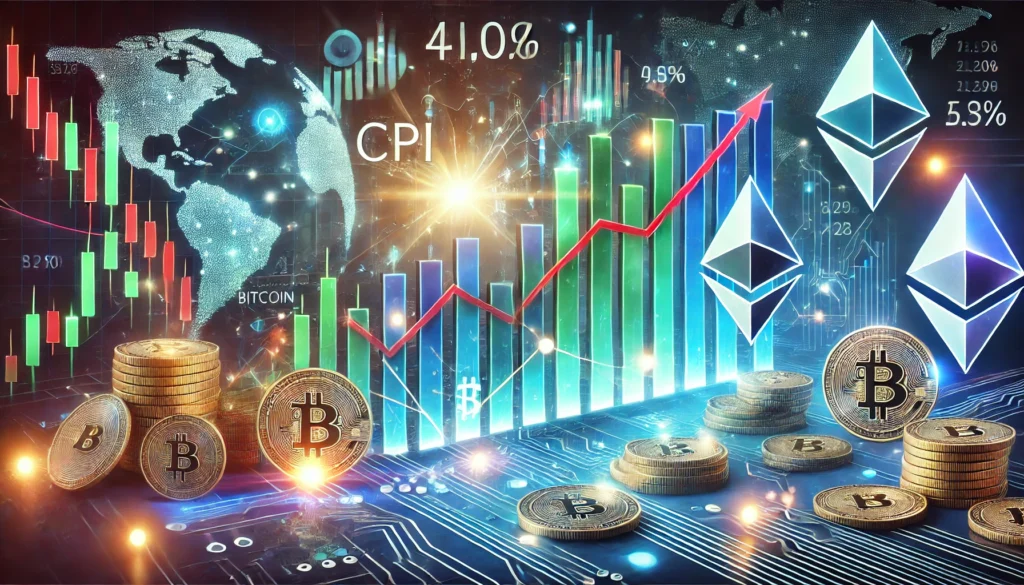
What Does CPI Inflation Mean for Crypto? How Consumer Price Index Data Impacts the Cryptocurrency Market
When it comes to financial markets, the Consumer Price Index (CPI) holds significant influence. As a key measure of inflation, the CPI has far-reaching implications not only for traditional assets like stocks and bonds but also for cryptocurrencies like Bitcoin (BTC) and Ethereum (ETH). With today’s release of new CPI data, many investors are bracing for potential volatility in the markets. But what exactly does CPI inflation mean for crypto, and how should investors prepare for various outcomes?
This article explores the relationship between CPI inflation data and the cryptocurrency market, using historical insights and today’s CPI expectations to shed light on potential scenarios. Whether you’re a seasoned trader or a curious observer, understanding CPI’s impact on crypto is essential for navigating this ever-evolving market.
What Is the Consumer Price Index (CPI)?
The Consumer Price Index is a widely-used metric that tracks the average change in prices paid by consumers for goods and services over time. Essentially, CPI measures inflation, giving us insights into the purchasing power of money.
Central banks, such as the Federal Reserve in the U.S., closely monitor CPI data to guide monetary policy decisions, including interest rate adjustments. Higher-than-expected inflation often prompts central banks to raise interest rates, while lower inflation may lead to more accommodative monetary policies. These decisions directly impact both traditional financial markets and cryptocurrencies.
Why CPI Data Matters for Crypto
Cryptocurrencies have emerged as a unique asset class, often characterized by high volatility and a strong correlation with macroeconomic trends. CPI data plays a pivotal role in influencing investor sentiment and capital flows across the financial landscape. Here’s why it matters for crypto:
- Inflation Expectations and Risk Assets: Cryptocurrencies, particularly Bitcoin, are often considered a hedge against inflation due to their fixed supply. However, they are also classified as high-risk assets. When CPI inflation data deviates significantly from expectations, it can trigger a chain reaction in risk assets, including cryptocurrencies.
- Market Sentiment: Inflation data directly affects market sentiment. For example, higher-than-expected inflation can lead to fears of tighter monetary policy, causing investors to exit risk assets. Conversely, lower-than-expected inflation can fuel optimism, driving a rally in riskier markets like crypto.
- Correlation with Traditional Markets: Cryptocurrencies like Bitcoin and Ethereum often exhibit a high correlation with traditional markets such as the S&P 500. CPI data that causes sharp movements in stock indices can spill over into the crypto market, amplifying price volatility.
Today’s CPI Data: A Key Catalyst for Crypto
At 8:30 AM U.S. time (14:30 CET), the new CPI data will be released, and the market is bracing for a potential shake-up. The previous year-on-year CPI figure was 2.7%, and today’s expectation is an increase to 2.9%.
Here’s what these numbers mean for crypto and what to expect in different scenarios:
Scenario 1: CPI Data Above 2.9%
If the reported CPI exceeds the expected 2.9%, it signals higher inflation than anticipated. This scenario could have the following effects on cryptocurrencies:
- Market Reaction: A higher than expected CPI could heighten the prospect of a pause in interest rate cuts or even fear of further interest rate hikes by the Federal Reserve. This may trigger a sell-off in risk assets, including Bitcoin, Ethereum, and altcoins.
- Buying Opportunities: Despite the initial decline, broader trends for BTC and ETH remain bullish. A sharp drop in crypto prices could present an attractive buying opportunity for long-term investors looking to accumulate assets at a discount.
- Volatility Ahead: The magnitude of the decline in crypto prices will depend on how much the reported CPI exceeds expectations. A significant upside surprise could result in heightened volatility, testing key support levels for major cryptocurrencies.
Scenario 2: CPI Data Matches Expectations (2.9%)
If the CPI data comes in line with the expected 2.9%, the market may remain relatively stable.
- Minimal Impact: In this scenario, the reported figure aligns with what investors have already priced into the market. As a result, we’re unlikely to see significant reactions in either direction for cryptocurrencies.
- Consolidation Phase: BTC and ETH may consolidate within their current trading ranges as traders wait for the next major catalyst. However, this could also be an opportunity for traders to assess market sentiment and prepare for future movements.
Scenario 3: CPI Data Below 2.9%
If the CPI comes in below the expected 2.9%, it could ignite a strong rally in risk assets, including cryptocurrencies.
- Market Optimism: Lower-than-expected inflation suggests the Federal Reserve may soon continue to cut interest rates. This could boost investor confidence and lead to a surge in demand for cryptocurrencies.
- Upside Potential: The magnitude of the rally will depend on how much the reported CPI falls below expectations. A significant downside surprise could result in Bitcoin and Ethereum breaking key resistance levels and entering a new bullish phase.
- Buying Strategy: Investors may want to prepare for potential purchases in BTC, ETH, and other altcoins if this scenario materializes. Identifying key support and resistance levels can help optimize entry points during a rally. For a seamless and secure buying experience, you can sign up for an Xcoins account, a trusted platform for all your crypto purchasing needs.
Historical Perspective: CPI and Crypto Market Movements
Historically, CPI data releases have had a pronounced impact on cryptocurrency prices. Significant deviations between expected and reported CPI figures often lead to sharp price movements. For example:
- Higher-than-Expected CPI: Past instances of CPI inflation exceeding expectations have triggered sell-offs in cryptocurrencies as investors anticipate tighter monetary policies.
- Lower-than-Expected CPI: On the other hand, lower CPI figures have historically fueled rallies in Bitcoin and Ethereum, as investors interpret this as a sign of dovish central bank policies.
Understanding these historical trends can help crypto investors better anticipate market reactions and develop more effective trading strategies.

Comments
Post a Comment